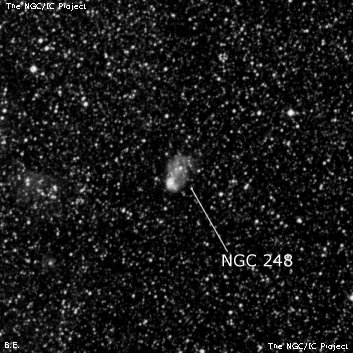
John Herschel discovered NGC 248 = h2344 on 11 Apr 1834 and logged "very faint. Below the pole, and the sweep otherwise irregular." On a later sweep he recorded "faint, elongated or binuclear, small, very gradually a little brighter in the middle." His position matches the knot at the southeast end.
Pietro Barachhi observed this cluster on 16 Dec 1887 along with a number of other SMC clusters with the 48" Melbourne telescope. He listed NGC 248 as two separate objects; the NW object (SMC-N13B) was labeled as "F" and called "pF; eeS a faint nebulous star" and the SE object was labeled as "G" (SMC-N13A) and described as "very close to F, almost forms a double nebula - this is a little brighter and larger than F. pB; vS; R; pmbM."
400/500mm - 18" (7/10/05 - Magellan Observatory, Australia): at 228x this fairly faint SMC nebulous cluster appeared as an irregular glow, 0.8'x0.6', elongated NW-SE. There was a good response using a UHC filter at 76x. One or two stars or knots are involved including a small nebulous knot at the southeast end. NGC 256 lies 8' SSE and NGC 242 is 9' SW.
Notes by Steve Gottlieb